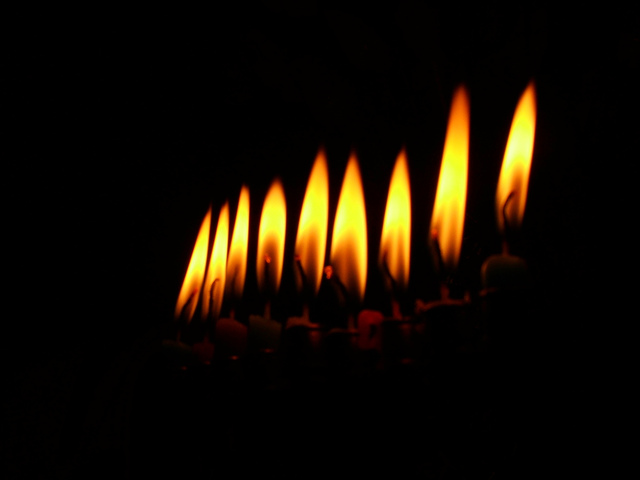{Originally posted to the JNS website}
Some messages are simply too important to ignore. One such message, I believe, emerges from two words in the Talmud’s short discussion of the Hanukkah festival. While overwhelmingly vital and powerful, however, this communication is easily missed. We have to be sensitive enough and honest enough to note it.
‘);
_avp.push({ tagid: article_top_ad_tagid, alias: ‘/’, type: ‘banner’, zid: ThisAdID, pid: 16, onscroll: 0 });
After briefly describing the Hasmonean victory over the Syrian Greeks and the miracle of the sole remaining cruse of oil, the Talmud states: “L’shana acheret, ‘to another year,’ [the rabbis] established and rendered [these eight days] permanent festival days with praise and thanksgiving.”
The talmudic record is clear. Hanukkah is not established immediately as a festival, but only in conjunction with “another year.” Faced with this assertion, many commentaries render the phrase l’shana acheret as “to the next year.” Hanukkah is established as an ongoing festival, these scholars maintain, one full year after the Hasmonean victory and the rededication of the Temple; once the rabbinic authorities recognize the full significance of the events that have transpired under their watch.
If this is the case, however, why doesn’t the Talmud use the specific language l’shana ha’ba’a, literally, “to the coming year?” Even if Hanukkah is established only a year later, might the rabbis be teaching us a lesson through their use of the broader phrase l’shana acheret?
A potential answer can be gleaned from the powerful observations of Rabbi Joseph Soloveitchik (the Rav) concerning Judaism’s approach to time. This great scholar identifies three dimensions of “time awareness” as essential to the life of each Jew: retrospection, anticipation and appreciation.
Retrospection refers to man’s ability to re-experience the past in the present. What for others is only a memory, the Rav maintains, must become for the Jew a “creative living experience.” To lead meaningful Jewish lives, our personal journeys must be actively shaped by the events and populated by the personalities of our peoples’ past.
Anticipation, according to the Rav, speaks of man’s projection of visions and aspirations into the future. Within this dimension, the Jew enters the realm of foresight and expectation. He recognizes the need to act now, in order to propel his dreams and his people’s dreams, forward.
The third and final dimension of time awareness, appreciation, is the most crucial of all. Here, the challenge is to recognize the unique nature of the here and now. So central is the dimension of appreciation, according to the Rav, that it lends meaning to the other two dimensions. “Retrospection and anticipation are significant only insofar as they transform the present.” The past and future are valueless to the Jew, the Rav maintains, unless they affect the way he/she acts now.
To go one step further, we might argue that appreciation is not only the most central of the three dimensions of time awareness, but also the most difficult one to enter.
To fully “appreciate” our times, we must learn to view our lives through the lens of history. The stipulations of appreciation thus form a fundamental imbalance: we must judge ourselves as we will be judged in the future; but we must render that judgment now. We are challenged to ask ourselves: One hundred, two hundred, five hundred years from now; how will our generation’s story and our generation’s contributions to Jewish life, be measured? Clearly, these are difficult questions to answer. Lessons from the past are easily accessed through hindsight. Visions of a glorious future are readily imagined. A true assessment of present opportunity, challenge and performance, however, can remain elusive. Such appraisal often seems to need the perspective granted by a shana acheret, “another year.” And waiting for a shana acheret is a luxury that we can generally ill afford.
In our day, few within the committed Jewish community would argue with the fact that the establishment and development of the State of Israel has been a transformative event, unequaled in thousands of years of Jewish history. We are privileged to be part of a continuing grand experiment replete with innumerable, ever-shifting facets: the ongoing return of a dispersed people from across the globe to its ancestral homeland; the cobbling together of disparate populations, vastly different from one another, into a working, functioning, governable democracy; the blending of Jewish tradition with democratic principle; the unaccustomed use of power by a people powerless for centuries; the forging of an ever-changing relationship between Diaspora Jewry and Israeli citizenry; the rapid rise of the new-born nation-state into an economic powerhouse; the development, by necessity, of an ever-adapting, world-class, powerful military and security apparatus; the positive changes wrought in the psyche of Jews across the globe because of the very existence of a Jewish state; and so much more . . .
And yet, a full appreciation of the extraordinary realities that mark our days can be difficult to maintain. Day to day, caught up in our own personal concerns and challenges; frustrated by the bureaucracy that confronts us; disappointed in the politics that seem to “govern our government;” it is easy to lose historical perspective. It is easy to lose sight of the miracle that greets us every time we walk through the streets of our homeland. It is easy to forget that, as an acquaintance recently observed: If any Jew who lived between 70 CE and 1945 CE miraculously came back to life today on the streets of Yerushalayim; he/she would not ask, “When will Moshiach come?” He/she would ask, “When did Moshiach come?”
Don’t get me wrong. Moshiach is not fully here quite yet. In fact, I firmly believe, the verdict is still out. Whether or not these miraculous days will turn out to be Reishit Semichat Ge’ulateinu (the beginning of the flowering of our redemption) will be up to us. Hashem is granting us an opportunity—one that had been unimaginable for thousands of years. What we do with that opportunity will ultimately determine its significance. Will we learn to live and work together towards the common good? Will we find a way to move forward as one, as we confront the many challenges that face us? Will we put aside the petty differences that too often mark our religious and political discourse? Will we succeed in creating a truly sanctified society? While, as mentioned above, the verdict is still out on these issues, one thing is clear. As a first step, we must arrive at a full awareness and appreciation of our time. Only if we recognize the historic potential that marks our day, can we hope to realize that potential.
Centuries ago, the Hasmoneans saved Judaism, only to ultimately fall victim to their own excesses and lost perspective. Could the Talmud be hinting at one of the reasons? Perhaps the rabbis are teaching us that: Had our ancestors recognized the true significance of the Hanukkah victories immediately—and not l’shana acheret—they would have successfully retained their footing in a turbulent world.
If we learn to fully appreciate the gifts Divinely granted to us in our day, perhaps, this time, we will also learn to appreciate the challenges they bear. And, just perhaps, we will rise to meet those challenges together while there is still time, l’shana ha’zot, “to this year.”
(Rabbi Shmuel Goldin is rabbi emeritus of Congregation Ahavath Torah in Englewood, N.J., and past president of the Rabbinical Council of America. He currently lives in Jerusalem)
‘);
_avp.push({ tagid: article_top_ad_tagid, alias: ‘/’, type: ‘banner’, zid: ThisAdID, pid: 16, onscroll: 10 });




